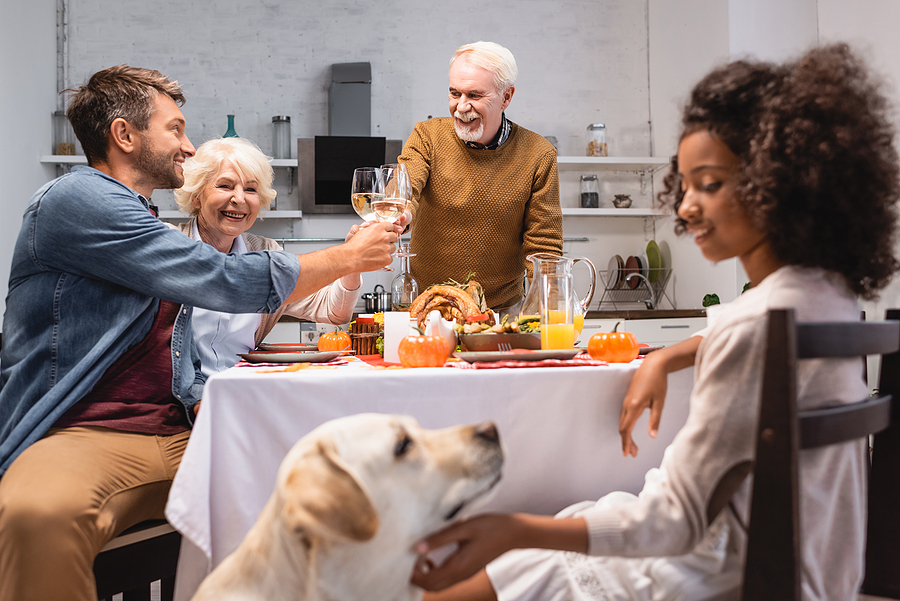Holiday celebrations include visits to or from family and friends. Since we consider cats and dogs part of the family, holiday visits that include them require special preparations. Changes to routine can increase fear, anxiety, and stress in everyone, especially our pets. Hitting the road also raises stress levels, so unless your pets adore car travel, prepare with advice in this article. Here are some tips for reducing the angst once you arrive, so that everyone enjoys the holiday.
Give pets space. Cats don’t always appreciate change, and meeting new pets can raise everybody’s stress levels. Give your cat private space. Choose a room with a solid door (maybe your guest bedroom) with the guest cat’s litter box, bed, food and water bowls, and portable scratch object. Your familiar scent helps keep kitty calm.
Gate for privacy. Dogs also appreciate their own room. For dogs and cats who enjoy meeting new people and pets, a pet gate allows them to meet and interact safely through the barrier. Confining the guest pet also helps keep the resident pets calm, feeling that only a small part of the home has been “invaded” by the stranger. Moveable baby gates can divide a hallway or stairs to segregate whole sections of the house when necessary and allows pets to be part of the festivities at a safe distance.
Treat for calm. Reward calm behavior with favorite munchies. You can also create positive associations between the guest pet and resident pets by offering yummies on opposite sides of the closed door or pet gate. This helps each identify the other pet’s presence with “good stuff” and helps relieve tension. You can also give your pets Zylkene (alpha-casozepine), a natural part of milk that helps calm pets of any age. Your pet won’t be sleepy, either. Zylkene helps to reduce the stress of travel and holiday visits.
Maintain routine. Pets love the status quo, so continue your normal schedule as much as possible. Feed the same food at the same times, in the same bowls, for example. Bring a favorite bed that smells like your dog or cat, so they have a familiar-smelling part of home. If you always go for a walk, or have a game at certain times, try to keep these favorite pet activities on your holiday schedule.
Let pets decide. Friends and family love to meet your pets, but don’t force interactions. Don’t overwhelm pets with too much attention and be ready to give dogs and cats a break in their guest room to decompress. Cats may prefer to hang out alone, while dogs often enjoy meeting new friends. If your pets aren’t used to children, for example, supervise to make sure everyone enjoys the interaction.
Leash the dogs. I’m a fan of management and preventing the possibility of trouble. At least until you know that your guest dog will get along with both the humans and resident pets, a leash keeps him and everyone else safe. Request that your family and friends also leash the resident dog for the same reason.
Supervise yard time. Give dogs private potty breaks until you’re sure your dog and the resident canine get along. Playtime can be fun, but you’ll want to remove any toys, bones, or other resources they might argue over. Tucked tail, growls, or fluffed fur mean a dog feels stressed or scared, so don’t force play. Watch for play bows (“elevator butt” posture) that invite interaction between dogs, after which you can allow five- to 10-minute periods of off-leash fun before separating them. Once your dog becomes buddies with the resident pets, you can extend the time.
We can’t always anticipate how pets will react to holiday pet visits. Maybe you love all your family–or maybe Uncle Al laughs too loud and weirds you out—but who knows if your pets will feel the same way. Manage expectations so you won’t feel disappointed. For short visits, hope for tolerance rather than love at first petting. And for longer visits, give your cats and dogs time to develop a deeper pet-friendly relationship.
This article was reviewed/edited by board-certified veterinary behaviorist Dr. Kenneth Martin and/or veterinary technician specialist in behavior Debbie Martin, LVT.
About Amy Shojai, CABC, Fear Free certified professional: A certified animal behavior consultant and award-winning author of more than 35 pet books, Amy speaks professionally, consults with the pet industry as a spokesperson, and is a founder and former president of the Cat Writers’ Association.
Brought to you by









